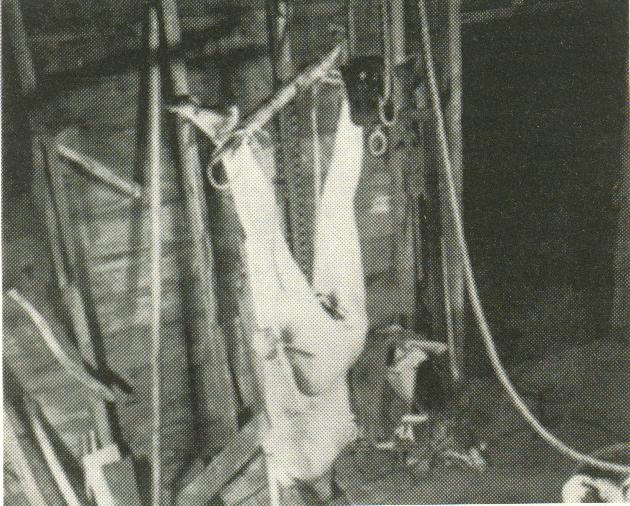My Life in Meat: Death as Art, Art as Death
by Travis Jeppesen on April 16, 2008
This essay was originally published in Czech translation in 2005. It appears here in the original English version for the first time. It is part of the forthcoming collection, Disorientations: Art on the Margins of the “Contemporary” (Social Disease, 2008).
I’m writing this in the United States of America, which, in case you didn’t know, is the fattest nation on Earth. Glancing at all the lard asses surrounding me, I sometimes wonder how I got let off the hook. I mean, I was a normal American kid by most standards. I grew up in the south, where the local cuisine dictates that everything including vegetables must be fried in animal fat, ate at McDonald’s several times a week, never exercised, often skipped out on gym class to smoke cigarettes and dope. Yet I was always a lightweight.
For a while I even stayed away from meat. I became a vegetarian, mostly to piss off my parents. It didn’t last long. Resisting the cunning allure of dead animals proved to be a futile effort, and I soon found myself eating them once again on a more or less regular basis.
Then one day, I became obsessed with serial killers. Of course I’d always known that monsters depicted in slasher films like Friday the 13th and Psycho existed in real life. What I learned in my research, though, is that a killer’s mania often stems from a lifelong fascination with dead things.
At a party, I was once fortunate enough to meet a sociologist whose research focused extensively on serial killers. We ended up talking at length about the psychopathology of every day life, and although we were freebasing cocaine at the time, her answers nevertheless shone some interesting light on the subject. For instance, the myth of pornography. Shortly before Ted Bundy was executed, he made some statement along the lines of “pornography is what made me savagely rape and butcher to death dozens of girls.” Of course pornography doesn’t cause psychopathic behavior; in fact, according to my crack-smoking sociologist friend, the common thread that links most of history’s more brutal serial killers isn’t porn, but horror films. Necrophiliac killer Jeffrey Dahmer, for example, used to watch The Exorcist 2 compulsively. In real life, Dahmer fetishized death in the same way that he saw it fetishized on screen. In the uncanny way that art and life feed off one another, Dahmer became an artist – a meat artist – keeping body parts of his victims around the house to play with and eat, with the ultimate goal of building a sort of shrine made out of his victims’ body parts – a shrine that he felt would heal him. Unfortunately, he was arrested before he had a chance to complete this masterpiece.
Ed Gein, a figure whose life was later used as a model for numerous horror films including Texas Chainsaw Massacre, took things even further. When police arrived at his Wisconsin farmhouse in the late ‘50s, they found a vast collection of meat art. In the woodshed of the farm was the naked, headless body of Bernice Worden, hanging upside down from a meat hook and slit open down the front. Her head and intestines were discovered in a box, her heart on a plate in the dining room. The skins from ten human heads were found preserved, and another skin taken from the upper torso of a woman was rolled up on the floor. There was a belt fashioned from carved-off nipples, a chair upholstered in human skin, the crown of a skull used as a soup-bowl, lampshades covered in flesh pulled taut, a table propped up by a human shinbones, and a refrigerator full of organs. The four posts on Gein’s bed were topped with skulls and a human head hung on the wall alongside nine death-masks – the skinned faces of women – and decorative bracelets made out of human skin. The stunned searchers also uncovered soup bowls fashioned from skulls, a shoebox full of female genitalia, faces stuffed with newspapers and mounted like hunting trophies on the walls, and a “mammary vest” flayed from the torso of a woman. Gein later confessed that he enjoyed dressing himself in this and other human-skin garments and pretending he was his own mother.
Then there are the numerous performance artists who have used meat – that is, the flesh of dead animals – in their actions. The most notable contributions to meat art were made in the 1960s by the Vienna Actionists (Rudolf Schwarzkogler, Hermann Nitsch, Otto Muehl, and Gunter Brus). Their actions, which rifled the feathers of the stiff Austrian public and resulted in jail time for many of the participants, often included the ritualistic slaughter of animals, whose innards were then smeared over the performers’ bodies, which were in turn treated like meat via self-mutilation.
In the late 1980s and early 1990s, a whole new generation of musicians who had been weaned on slasher flicks began forming metal bands, making a lot of terrible noise while belching out lyrics using grotesque medical terminology to describe impossibly fatal and disgusting bodily quandaries. Grindcore was born, and in the center of it all was a band called Carcass, with song titles like “Swarming Vulgar Mass of Infected Virulency” and “Cadaveric Incubator of Endoparasites.” While Carcass isn’t around anymore, this initial strain of grindcore still exists today in the form of gore metal, represented by bands like Haemorrhage and Exhumed.
For the first time in history, the last century’s carnivorous artwork has assigned a new pertinence to dead flesh – namely, meat as muse and matter. These artists have made the ultimate Cartesian split, refusing to deify the human body by viewing it as merely another material in the penultimate vision guiding their creations. In an aesthetic universe, vision alone takes precedence over everything else, transcending all the conflicts and traumas imposed on the psyche by the meat we carry around inside us – the very meat that unites us with nature and guides us in our efforts to destroy this nature as loudly as possible. For it is in those desultory orgiastic explosions of violence – the ultimate desecration of the sacred body – that truth subsides on this lowly earthly plane.



One comment
Carcass is alive and well, thankfully and used medical /surgery techniques and fatal/chronic illnesses in their lyrics and music as a joke…It started as a joke….Its not meant to be taken seriously…..never was.
by Alex on February 27, 2011 at 9:35 am. #